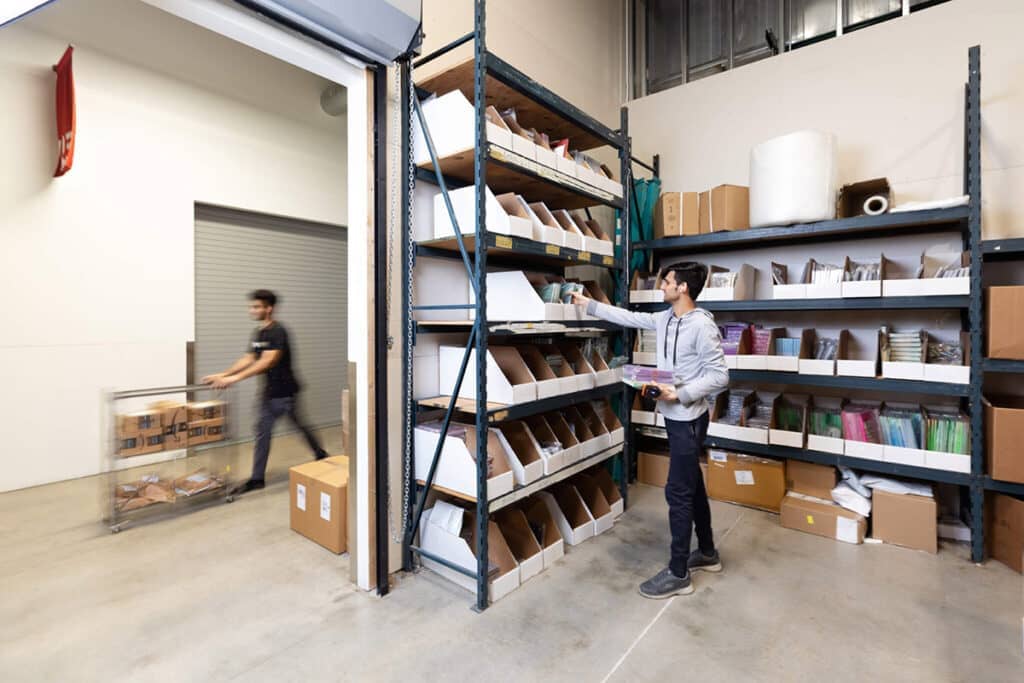Selecting the best shipping carrier for your business is a key factor in maintaining efficient operations and meeting customer expectations. UPS, USPS, and FedEx each offer a range of services that cater to different shipping needs, from cost-effective solutions for small packages to fast, reliable delivery options for urgent shipments. Understanding the nuances of these carriers – such as pricing, speed, and coverage – can help you make an informed decision that benefits your business.
In this post, we will cover:
- An overview of the services, pricing, and special features of UPS, USPS, and FedEx.
- A cost comparison of the three carriers, including factors that influence shipping rates.
- Key considerations for selecting the best carrier for your specific business needs.
Overview of Major Shipping Carriers: UPS, USPS, and FedEx
The three major US shipping carriers – UPS, USPS, and FedEx – offer a range of services tailored to different types of shipments, both domestic and international. Here’s a breakdown of what they offer.
UPS shipping breakdown
UPS is known for its reliable tracking system and a wide range of shipping options. Services include UPS Ground, 3-Day Select, and Next Day Air, and international shipping, making UPS a great option for businesses that require flexible delivery options.
The pricing structure for UPS includes base rates determined by package weight, size, and destination, but can also include additional fuel surcharges, residential delivery fees, and oversized handling fees.
UPS also provides special features such as My Choice, which allows recipients to manage their deliveries, and Access Points, a convenient way for customers to pick up packages from nearby locations. As with most carriers, UPS provides options for real-time tracking of shipments.
Pros of UPS
- Reliable, real-time tracking capabilities.
- Strong international reach, making it ideal for global shipments.
- A variety of flexible delivery options, including same-day and next-day services.
- Business-friendly solutions such as volume discounts and loyalty programs.
Cons of UPS
- Higher shipping costs, especially for smaller or lighter packages.
- Additional surcharges for fuel, residential deliveries, and oversized items.
- Free package pickup is limited unless a regular schedule is arranged.
USPS shipping breakdown
USPS is often regarded as the most affordable option for shipping small packages and lightweight items. Their services include Priority Mail, First-Class Mail, and Media Mail for educational materials. Pricing can be either weight-based for domestic and international shipments or flat-rate such as for Priority Mail. USPS is unique in offering free package pickup and Saturday deliveries, making it a convenient choice for businesses and customers alike. Unlike other carriers, USPS delivers to PO boxes and rural addresses without additional surcharges.
Pros of USPS
- Competitive rates for small packages with no fuel surcharges.
- Free shipping supplies with Priority Mail services, which helps reduce packaging costs.
- Delivers to every address in the U.S., including remote areas and PO boxes.
Cons of USPS
- Delivery times for standard options are generally slower than those of UPS and FedEx.
- Less comprehensive tracking information, especially for lower-cost services.
- Size and weight restrictions on some services, such as First-Class Mail.
FedEx shipping breakdown
FedEx is well-known for its express shipping services and a variety of specialized shipping solutions. The company offers services such as FedEx Ground, FedEx Express, and FedEx Freight, with tiered pricing based on delivery speed and package dimensions. FedEx also provides specialized options for shipping hazardous materials, healthcare products, and perishable goods. FedEx’s Delivery Manager tool enhances the customer experience by allowing recipients to customize their delivery options, and their advanced tracking tools provide real-time updates on shipment progress.
Pros of FedEx
- Expedited shipping options with guaranteed delivery times, making it ideal for time-sensitive shipments.
- Advanced tracking with real-time updates and notifications.
- Strong international shipping capabilities with an extensive global network.
- Specialized services for industries with unique shipping needs, such as healthcare, hazardous materials, and perishable goods.
Cons of FedEx
- Often higher shipping rates compared to USPS, particularly for expedited services.
- A complex pricing structure with various surcharges, making it harder to estimate total costs.
- Fewer drop-off and pickup locations compared to USPS.
Comparing Shipping Costs: USPS vs. UPS vs. FedEx
With pricing structures and shipping options varying between carriers, comparing shipping costs can sometimes be challenging. Here’s a general comparison of starting rates for standard ground shipping, 3-day express, and overnight services:
For smaller, lightweight packages, USPS offers the most competitive rates, while UPS and FedEx are better suited for larger packages or when speed is essential.
What USPS costs include
- Flat-Rate Shipping: USPS offers flat-rate shipping options, which include shipping supplies like boxes and envelopes and delivery confirmation services.
- Fuel and Residential Delivery: USPS rates are all-inclusive, meaning no additional surcharges for fuel or residential delivery.
- Extra Services: Additional services, such as insurance, certified mail, and signature confirmation, are available for a fee.
What UPS costs include
- Base Rate: UPS’s base rate is determined by the package weight, size, and destination.
- Surcharges: UPS adds surcharges for fuel, residential deliveries, and handling oversized items, so it’s important to factor these in when calculating total costs.
- Optional Services: UPS offers extra services like insurance, guaranteed delivery windows, and Saturday delivery for an additional charge.
What FedEx costs include
- Service Level Pricing: FedEx offers various pricing tiers based on service speed (Ground, Express, Overnight).
- Additional Fees: FedEx applies surcharges for fuel, residential deliveries, and oversized handling, which can increase the overall cost of shipping.
- Premium Services: Additional services such as Saturday delivery, insurance, and signature requirements come with extra fees.
How to cut shipping carrier costs
Shipping costs are primarily driven by package size, weight, and the chosen delivery speed. Larger and heavier packages increase shipping fees, and choosing expedited services such as Overnight or 2-Day significantly raises costs. Carriers also calculate dimensional weight, so using smaller, more efficient packaging can help minimize charges.
Cost Breakdown for Small Packages
For small and lightweight packages, USPS often offers the most affordable rates with services like First-Class Mail and Priority Mail Flat Rate. UPS and FedEx tend to be more expensive for smaller packages but may be advantageous when faster delivery is required. To accurately estimate your shipping costs, use a shipping calculator like Parcel Monkey, which allows you to compare rates across multiple carriers instantly.
Cost Breakdown for Large Packages
For larger or heavier shipments, UPS and FedEx provide more reliable options with services like UPS Ground and FedEx Freight. These carriers are better equipped to handle oversized items but often come with higher shipping costs due to dimensional weight pricing and additional handling fees. To reduce costs, businesses can optimize packaging by minimizing dimensional weight and consider using services like Less than Truckload (LTL) shipping for particularly large items.
Shipping costs can add up and substantially subtract from your bottom line. Fortunately, there are some ways to reduce shipping carrier costs:
1. Select standard shipping
Choosing standard shipping for non-urgent deliveries can significantly cut costs compared to express or overnight options. It’s an ideal solution for shipments with flexible delivery windows, allowing businesses to maintain low shipping expenses.
2. Ship from closer shipping zones
Store inventory closer to major customer bases to reduce shipping zone distances and decrease shipping costs. If you have customers from across the country, consider using small warehousing space to store your inventory in multiple locations.
3. Ask for discounted shipping ratesw
Carriers often provide discounted rates for businesses that ship in bulk or agree to long-term contracts. Negotiating based on your shipping volume can lead to lower per-package costs, making your shipping more cost-efficient over time.
4. Switch to poly mailers
For smaller items, poly mailers are a lightweight, cost-effective alternative to boxes. They reduce dimensional weight charges and are ideal for shipping items like clothing or non-fragile products.
5. Optimize your packaging size
Carriers calculate costs based on dimensional weight, so reducing your package size can help you avoid unnecessary surcharges. Using appropriately sized packaging not only cuts costs but also reduces waste and other unnecessary costs.
6. Small Warehouse Space
Warespace provides small warehouse space so that you can ship inventory from much closer to its end destination. This not only minimizes shipping costs, but also helps reduce delivery times and improve customer satisfaction.
Speed and Reliability: How Quickly Will Your Package Arrive?
Each carrier offers a variety of shipping speeds to meet different business needs:
- USPS: Provides Priority Mail Express (overnight), Priority Mail (1-3 days), and First-Class Mail, which is ideal for non-urgent shipments.
- UPS: Offers Next Day Air, 2-Day Air, and UPS Ground, which takes 1-5 days depending on the shipping zone.
- FedEx: Known for its speed, FedEx provides Same-Day, Overnight, and 2-Day services. FedEx Ground typically delivers within 1-5 business days.
FedEx and UPS are top choices for fast delivery, with FedEx leading in same-day and express services. USPS is the slower, more affordable choice for businesses looking to save on costs for standard shipments.
Reliability and Track Record
Each carrier has a strong reputation for reliability, but differences exist in their on-time performance:
- UPS consistently leads the industry with a 97.5% on-time delivery rate, making it a top choice for businesses prioritizing reliability (About UPS-US)
- FedEx follows closely with a 95.2% on-time rate, making it highly dependable for urgent and time-sensitive deliveries (About UPS-US)
- USPS has a slightly lower on-time performance at 94.3%, which is still respectable, particularly for standard shipping services (RushCX)
All three carriers provide robust customer service, but UPS and FedEx generally offer more comprehensive tracking and quicker resolutions for lost or delayed packages compared to USPS.
Coverage and Accessibility: Reaching Your Customers
Domestic Shipping Coverage
- USPS: Offers the most extensive domestic coverage, delivering to every address, including PO boxes and rural areas, making it the best option for hard-to-reach locations. However, it may face slower delivery in remote areas.
- UPS: Strong in urban and suburban regions, but with added fees for rural deliveries. It doesn’t deliver to PO boxes, limiting accessibility for some customers.
- FedEx: Broad urban coverage but less efficient for rural areas and no PO box deliveries. Additional fees may apply for remote locations.
International Shipping Capabilities
- USPS: Cost-effective for small, lightweight international shipments, but slower, with less predictable customs handling.
- UPS: Known for fast, reliable international shipping, with efficient customs clearance but higher costs.
- FedEx: Strong global network and fast delivery options like International Priority, but it is often the most expensive for expedited international shipments.
In short, USPS is ideal for cost-sensitive, light international shipments, while UPS and FedEx offer faster options for urgent, high-value deliveries.
Shipping Solutions for Specific Needs
For small-scale operations, USPS is often the most cost-effective carrier, especially for businesses shipping lightweight packages. With no additional surcharges for residential deliveries and competitive rates for small parcels, USPS is ideal for small businesses sending occasional shipments.
For slightly larger shipments, UPS and FedEx may offer better rates, particularly when businesses can negotiate volume-based discounts.
For e-commerce businesses, balancing cost with delivery speed is key to maintaining customer satisfaction. FedEx and UPS provide reliable, fast shipping options, making them ideal for retailers that need efficient shipping solutions to meet customer demand for quick delivery.
Managing returns is also crucial in e-commerce. Both FedEx and UPS offer return shipping solutions that are easy to integrate into e-commerce systems, helping businesses improve customer satisfaction by streamlining the returns process.
Best Way to Ship Large Packages
When it comes to oversized or heavy shipments, UPS and FedEx are the best options. Both carriers handle large packages efficiently and offer specialized services like Freight or Less than Truckload (LTL) shipping. For extremely large or bulky items, FedEx Freight or UPS Freight provide tailored shipping solutions, ensuring the safe and timely delivery of large packages that exceed standard size and weight limits. USPS, while excellent for smaller shipments, is less equipped to handle very large packages due to its size and weight restrictions.
Integrating Shipping Carriers with Your Business Operations
UPS, USPS, and FedEx offer robust shipping software integrations that streamline business operations. These carriers provide APIs and plugins that connect directly to e-commerce platforms like Shopify and WooCommerce, automating key tasks such as printing labels, tracking shipments, and calculating rates. For instance, UPS’s Developer Kit API and FedEx’s Ship Manager API simplify shipping workflows, while USPS integrates through services like Stamps.com to offer efficient small-package shipping solutions.
Setting up business accounts with these carriers unlocks benefits like volume discounts, loyalty programs, and dedicated customer support. UPS and FedEx offer discounted rates for bulk shipping and assign account managers for ongoing support. USPS offers Commercial Base Pricing, providing cost-effective solutions for frequent shippers, helping businesses cut costs and optimize their shipping strategies.
Which Carrier is Right for Your Business?
When choosing between UPS, USPS, and FedEx, the right carrier for your business depends on several factors. USPS excels at cost-effective solutions for small and lightweight packages, especially with its flat-rate services and wide domestic reach. UPS stands out for reliable tracking, fast shipping, and its robust international services, making it ideal for businesses handling larger shipments or requiring express delivery. FedEx offers a strong balance of speed and international options, particularly for time-sensitive or specialized deliveries, such as healthcare or hazardous materials.
Ultimately, the best carrier for your business will depend on your specific shipping needs, including package size, delivery speed, and customer base. It’s a good idea to test multiple carriers to evaluate costs, delivery times, and customer satisfaction. Start by considering your business size, shipping volume, and the importance of speed versus cost. By doing so, you can make an informed decision that aligns with your business goals and ensures a positive customer experience.









 ►
Explore 3D Space
►
Explore 3D Space